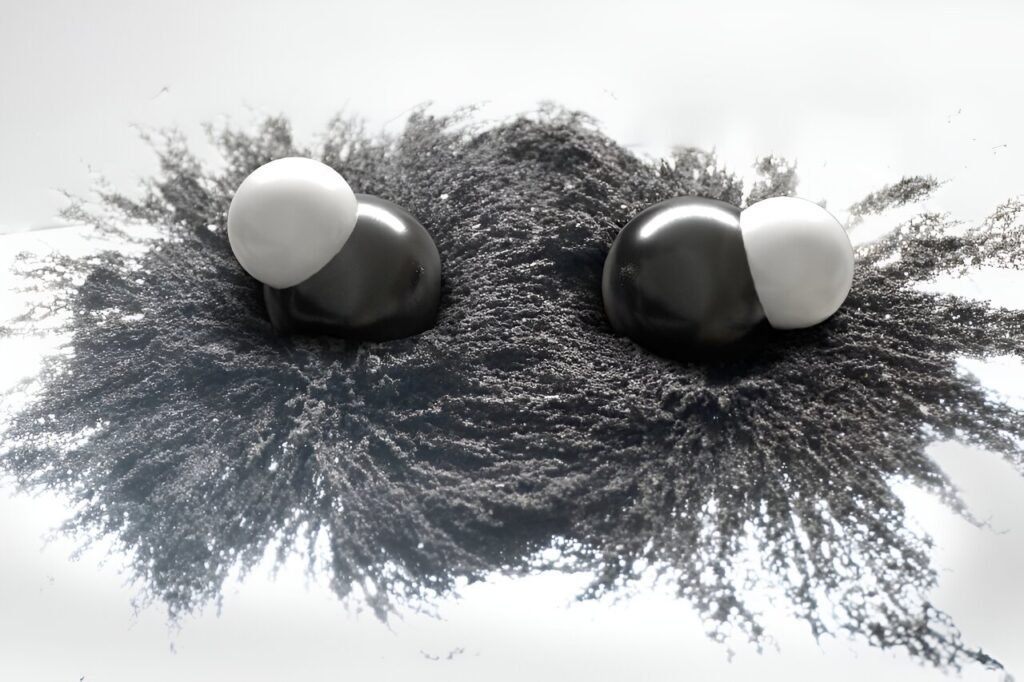× close
Two diatomic molecules are located in an intermolecular potential, represented here by iron filings showing the lines of force that bind the two molecules. Credit: © Christoph Hohmann, MCQST
A team of experimenters from the Max Planck Institute for Quantum Optics (MPQ) and theorists from the Chinese Academy of Sciences (CAS) has succeeded for the first time in creating and stabilizing a new type of molecule, the so-called field-bonded tetraatomic molecule. . These “supramolecules” are so fragile that they can only exist at extremely low temperatures. Their existence has long been suspected, but until now has never been experimentally demonstrated.
The polyatomic molecules created in this new study are made up of two or more atoms and were successfully cooled to 134 nanoKelvin, more than 3,000 times lower than the temperature of previously created tetraatomic molecules. This result is not only a new feat in molecular physics, but also an important step forward in the study of exotic ultracold materials. Research is published in Nature.
About 20 years ago, American theoretical physicist John Bourne and his colleagues predicted a new type of bond between polar molecules. When molecules have asymmetrically distributed charges (what physicists call polarity), they can combine in an electric field to form weakly bound “supramolecules.” ”
The behavior of these polar molecules can be thought of as a compass needle inside a hard shell. When you bring the compass needles closer together, they exert a stronger gravitational pull than the Earth’s magnetic field, causing them to point in each other’s directions instead of pointing north.
A similar phenomenon is observed with polar molecules, which under certain conditions can form unique bond states due to electrical forces. Their bond is reminiscent of a couple who dance while tightly embracing each other, always keeping a certain distance from each other.
Supramolecular bonds are much weaker than typical chemical bonds, but they also have much longer reach. Supramolecules share bond lengths over distances hundreds of times longer than normally bound molecules.
This long-range nature makes such supramolecules very sensitive. A small change in the electric field parameters at a critical value results in a dramatic change in the forces between the molecules. This is a phenomenon called “field-linked resonance.” ” This allows researchers to use microwave fields to flexibly change the shape and size of molecules.
A three-part play: From diatomic molecules to tetraatomic molecules
Ultracold polyatomic molecules contain rich internal structures that offer exciting new possibilities in low-temperature chemistry, precision measurements, and quantum information processing. However, their high complexity compared to diatomic molecules poses major challenges to the adoption of traditional cooling techniques such as direct laser cooling and evaporative cooling.
Researchers from MPQ’s “NaK Laboratory” (Sodium Potassium Laboratory), led by Dr. Xin-Yu Luo, Dr. Timon Hilker, and Professor Immanuel Bloch, have achieved a series of pioneering studies and research results. Nature-In recent years, we have published important discoveries to finally overcome this challenge.
First, in 2021, researchers at this lab will invent a new cooling technique for polar molecules using high-power rotating microwave fields, which will allow them to cool down to minus 273.15 degrees Celsius, 21 billionths of a degree above absolute zero. A new low temperature record was set.
A year later, the researchers were able to create the conditions necessary to observe for the first time traces of bonding between these molecules in scattering experiments. This provided the first indirect evidence of the existence of these exotic constructs, which had long been predicted by theory.
For more information:
Xing-Yan Chen et al, Cryogenic Field Bonded Tetraatomic Molecules, Nature (2024). DOI: 10.1038/s41586-023-06986-6

